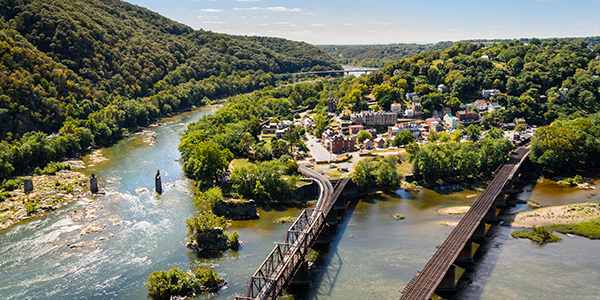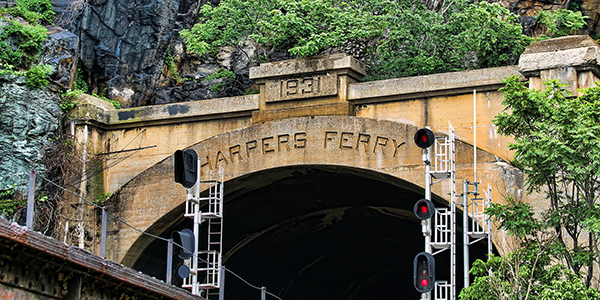

Harper’s Ferry
Journey to the past in a historic town
Bordered by the Potomac and Shenandoah Rivers, the quaint 19th-century village of Harper’s Ferry seduces visitors with its charm, history and a stunning natural setting. A living history village within Harper’s Ferry National Park, the town’s tidy web of streets is punctuated with historic homes, Civil War-era sights and compelling stores that purvey everything from antiques, handicrafts and souvenirs to outdoor gear. Harper’s Ferry’s museums and landmarks commemorate abolitionist John Brown’s 1859 rebellion and the town’s seminal role in the Civil War (it changed hands between the Union and the Confederacy eight times and witnessed the largest surrender of Union troops) as well as the town’s industry prowess from the early 1700s until the Depression of the 1930s.
Here are some of the town’s highlights:

Getty Images/iStockphoto
Harper’s Ferry National Park
With 2,300 acres draped across three states, Harper’s Ferry National Historical Park is one of West Virginia’s undisputed highlights. Incorporating Harper’s Ferry living history village, the park’s educational activities include conversations with historic reenactors playing Union soldiers, blacksmiths and more. Visit a boarding house and bakery to experience the region’s history and bucolic beauty.
The interactive Black Voices exhibit presents first-person accounts of the challenges and accomplishments of African Americans, from slavery through the Civil Rights era. Also in town, an array of outfitters arrange rafting, whitewater rafting, tubing and kayaking trips in the National Park, which is laced with mile after mile of hiking and biking trails for all capabilities, including segments of the Appalachian Trail and historic logging trails.
John Brown Museum
Across from Arsenal Square, the well curated John Brown Museum comprises three galleries with several engaging exhibits that present the life of the revered abolitionist and the course of his rebellion, capture, conviction and hanging. In 1859, Brown set out to arm the nation’s slaves and usher in a rebellion. Along with 19 enlisted men, Brown raided and captured town’s federal arsenal but failed to raise sufficient slaves into rebellion; the event proved to be a major catalyst for the Civil War and led to the inception of one of the U.S.’s first integrated schools. For a different (and more child-friendly) angle, the John Brown Wax museum is a private wax museum that features wax models and dioramas. Kids love it.

Getty Images/iStockphoto
John Brown Fort
Also on the John Brown trail — and for many, the town’s most symbolic attraction — visitors can pay homage to the abolitionist at John Brown’s Fort (built in 1848). It was in this small guardhouse, close to the armory, that John Brown and his followers barricaded themselves in before Lt. Colonel Robert E. Lee’s army stormed the building. The fort was sold in 1891 and sent to the Chicago World Fair for public exhibition where it was met with such disinterest that the fort was dismantled and eventually returned to Harper’s Ferry; it’s now located a few hundred feet from the original site.
The Harper House
Overlooking High Street, evocatively accessed by stone stairs, Harper House is the oldest edifice in Harper’s Ferry (built between 1775 and 1782). In 1747, Harper, a revered builder and millwright, was commissioned by some Quakers to construct a meeting house in the Shenandoah Valley close to what is now Winchester. In 1775, Harper set out to build a new home in the Lower Town but died before it was complete and he never lived in the home. The building became a tavern and hosted such notables as Thomas Jefferson and George Washington.
For More Information
Harper’s Ferry National Historical Park
304-535-6029
West Virginia Division of Tourism
800-225-5982